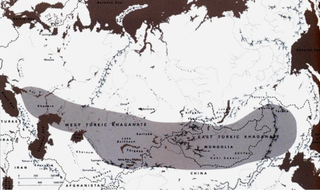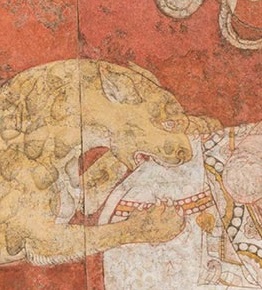
The Silk Road was a network of Eurasian trade routes active from the second century BCE until the mid-15th century. Spanning over 6,400 kilometers, it played a central role in facilitating economic, cultural, political, and religious interactions between the East and West. First coined in the late 19th century, the name "Silk Road" has fallen into disuse among some modern historians in favor of Silk Routes, which more accurately describes the intricate web of land and sea routes connecting East and Southeast Asia, the Indian subcontinent, Central Asia, the Middle East, East Africa and Europe.

Sogdia or Sogdiana was an ancient Iranian civilization between the Amu Darya and the Syr Darya, and in present-day Uzbekistan, Turkmenistan, Tajikistan, Kazakhstan, and Kyrgyzstan. Sogdiana was also a province of the Achaemenid Empire, and listed on the Behistun Inscription of Darius the Great. Sogdiana was first conquered by Cyrus the Great, the founder of the Achaemenid Empire, and then was annexed by the Macedonian ruler Alexander the Great in 328 BC. It would continue to change hands under the Seleucid Empire, the Greco-Bactrian Kingdom, the Kushan Empire, the Sasanian Empire, the Hephthalite Empire, the Western Turkic Khaganate and the Muslim conquest of Transoxiana.

Zhou, known in historiography as the Northern Zhou, was a Xianbei-led dynasty of China that lasted from 557 to 581. One of the Northern dynasties of China's Northern and Southern dynasties period, it succeeded the Western Wei dynasty and was eventually overthrown by the Sui dynasty.

The Dahae, also known as the Daae, Dahas or Dahaeans were an ancient Eastern Iranian nomadic tribal confederation, who inhabited the steppes of Central Asia.

Sabao was an official Chinese title in the 5th-7th centuries CE, used for government-appointed leaders of the Sogdian immigrant-merchant community. The word sabao is derived from the Sogdian word s’rtp’w, "caravan leader". Sabaos also often had titles of "Prefects", with regional responsibilities, in the Chinese administration : An Jia was Sabao and Grand Governor of Tong Prefecture.

The Chinvat Bridge or the Bridge of the Requiter in Zoroastrianism is the sifting bridge, which separates the world of the living from the world of the dead. All souls must cross the bridge upon death. The bridge is guarded by two four-eyed dogs, described in the Videvdat (Vendidad) 13,9 as 'spâna pəšu.pâna'.

The First Turkic Khaganate, also referred to as the First Turkic Empire, the Turkic Khaganate or the Göktürk Khaganate, was a Turkic khaganate established by the Ashina clan of the Göktürks in medieval Inner Asia under the leadership of Bumin Qaghan and his brother Istämi. The First Turkic Khaganate succeeded the Rouran Khaganate as the hegemonic power of the Mongolian Plateau and rapidly expanded their territories in Central Asia, and became the first Central Asian transcontinental empire from Manchuria to the Black Sea.

Central Asian art is visual art created in Central Asia, in areas corresponding to modern Kyrgyzstan, Kazakhstan, Uzbekistan, Turkmenistan, Azerbaijan, Tajikistan, Afghanistan, Pakistan, and parts of modern Mongolia, China and Russia. The art of ancient and medieval Central Asia reflects the rich history of this vast area, home to a huge variety of peoples, religions and ways of life. The artistic remains of the region show a remarkable combinations of influences that exemplify the multicultural nature of Central Asian society. The Silk Road transmission of art, Scythian art, Greco-Buddhist art, Serindian art and more recently Persianate culture, are all part of this complicated history.

The Tomb of Wirkak (Sogdian: wyrkʾk), in Chinese commonly referred to as Tomb of Master Shi (Chinese: 史君墓; pinyin: Shǐ Jūn Mù; Wade–Giles: Shih3-Chün1 Mu4), is the grave of the Sogdian Sabao (Chinese: 薩保, "Protector, Guardian", derived from the Sogdian word s’rtp’w, "caravan leader") Wirkak and his wife Wiyusi, dating from 580 AD (Northern Zhou dynasty). The tomb was discovered in 2003 in the east of Jingshang village in Daminggong township, Weiyang District, Xi'an, and excavated between June and October in the same year. It is especially significant for the rich content of the reliefs on the stone structure contained in the tomb and a bilingual epitaph. Sogdian tombs in China are among the most lavish of the period in this country, and are only slightly inferior to Imperial tombs, suggesting that the Sogdian Sabao were among the wealthiest members of the population.

Sogdian art refers to art produced by the Sogdians, an Iranian people living mainly in ancient Sogdia, present-day Uzbekistan, Tajikistan, Kazakhstan, and Kyrgyzstan, who also had a large diaspora living in China. Its apex was between the 5th and 9th centuries, and it consists of a rich body of pre-Muslim Central Asian visual arts. New finds recovered in the past decades allowed scholars to achieve a better understanding of Sogdian art.

The Tomb of Xu Xianxiu is located in Wangjiafeng village, Haofeng Township, Yingze District, Shanxi Province, China. It is the tomb of the Northern Qi Prince of Wu’an, and head of the imperial armies, Xu Xianxiu. The tomb, noted for its murals, was excavated during 2001-2003.

Hufu, also referred as Hu clothing, nomadic dress, 'barbarian' clothing or dress, or foreign dress, is a generic term which refers to any clothing which was worn in ancient China and its surrounding regions by non-Han Chinese people. This term is also used to refer to foreigner's dress or clothing of foreign origins in ancient China. The introduction of Hufu-style garments and attire in China occurred by the time of King Wuling of Zhao.

Rong Xinjiang is a Chinese historian who is a professor at Peking University, currently serving as chairperson of Academic Committee of Department of History and chairperson of Center for Research on Ancient Chinese History. He is also the Cheung Kong Scholars Distinguished Professor of the Ministry of Education, vice chairperson of the Tang Dynasty Institute of China and the Dunhuang and Turpan Institute of China.

The Silver Deer of Bilge Khan is a 7th- or 8th-century silver and silver-gilt artifact extracted from the tomb of Bilge Qaghan, the burial complex of the fourth Qaghan of the Second Turkic Khaganate. It was discovered in 2001 during excavations carried out in Orkon Valley, at the future Bilge Khan Monumental Grave Complex, located about 400 km (250 mi) from Mongolia's capital Ulaanbaatar, between the Orkhon River and Khosho Tsaydam Lake.

The Tomb of Ān Jiā, also sometimes read Ān Qié, is a Northern Zhou period funeral monument to a Sogdian nobleman named "Anjia" in the Chinese epitaph. The tomb was excavated in the city of Xi'an. It is now located in the collections of the Shaanxi Provincial Institute of Archaeology. An Jia (安伽) died in the founding year of the Daxiang (大象) era, during the reign of Emperor Jing.

The Anyang funerary bed, also known locally as the Bed of Ts'ao Ts'ao, is a Chinese funerary couch belonging to a Sogdian merchant and official active in China in the 6th century CE. The tomb was discovered in 1911, and the components of the funerary bed were dispersed among various museums in the world after being offered on the art market. It is thought the funerary bed was excavated in Anyang, capital of the Northern Qi dynasty. It is stylically dated to the Northern Qi dynasty.

The Miho funerary couch is a Northern Dynasties period funeral monument to a Sogdian nobleman and official in northern China. The tomb is now located in the collections of the Miho Museum. Its structure is similar to that of the Anyang funerary bed. It has been dated to circa 570 CE. It is rumoured to have been excavated in Taiyuan in the 1980s, before being sold on the American art market.

The Tomb of Kang Ye is a Northern Zhou period funeral monument to a Sogdian nobleman and official in northern China named Kang Ye in his epitaph. The tomb was discovered in the northern suburbs of Xi'an in 2004. It is now located in the collections of the Xi'an City Museum. It is dated to 571 CE, from the epitaph.

The Tomb of Ān Bèi, is a 589 CE funeral monument of a Sogdian man named "An Bei" in his Chinese epitaph. The tomb was looted in 2006-2007, and its content sold in the art market. Part of the base of the tomb as well as the epitaph are now in the Tang West Market Museum (大唐西市博物館) in Xi'an.

The Tianshui tomb, also Tomb of Shimaping (Chinese:石马坪粟特墓) is a Sui dynasty funerary monument of an anonymous Sogdian nobleman and official in northern China. The tomb was discovered in the northern city of Tianshui in 1982. It is now located in the collections of the Tianshui City Museum (天水市博物馆). It is one of the major known examples of Sogdian tombs in China.





















